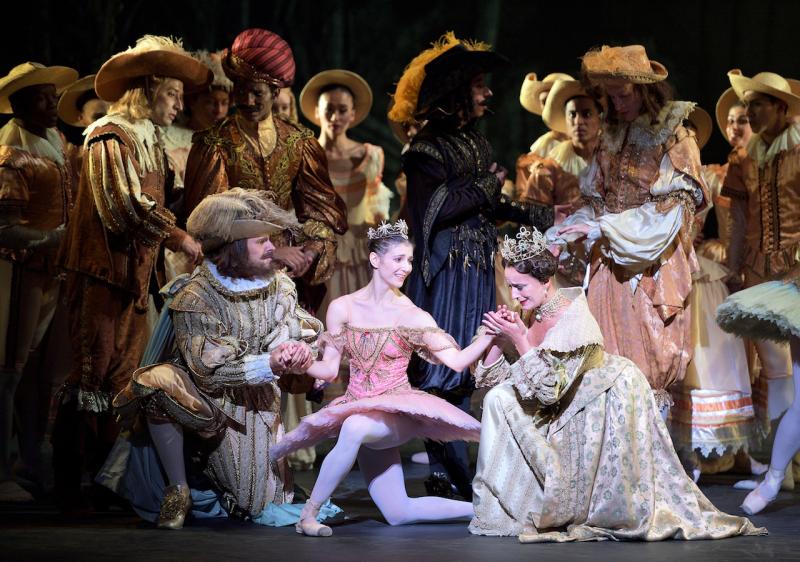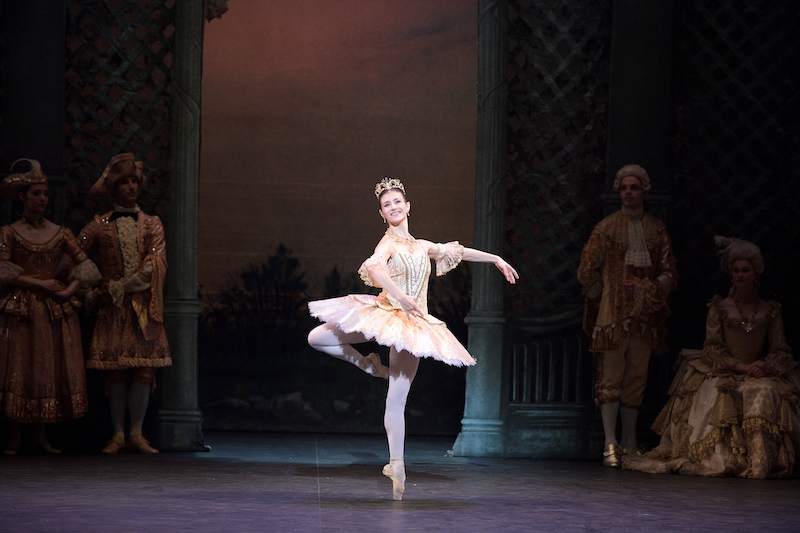The Sleeping Beauty, London Coliseum review - a triumph for English National Ballet | reviews, news & interviews
The Sleeping Beauty, London Coliseum review - a triumph for English National Ballet
The Sleeping Beauty, London Coliseum review - a triumph for English National Ballet
Kenneth MacMillan's timeless staging brings out the best in ENB

When Tamara Rojo won the top job at English National Ballet in 2012, it looked like a poisoned chalice. Directors had come and gone, some of them with visionary ideas, but all were defeated by the company’s peculiar position as underdog to the company at Covent Garden.
Of all the Tchaikovsky ballets, perhaps of all ballets, The Sleeping Beauty is the greatest test of a company’s classical technique, demanding power and precision in depth from every rank, from the soaring, flutter-toed Bluebird to the comical trio of knitting women forced to surrender their needles, from every cavalier of every solo fairy, even from Red Riding Hood in her flighty cameo towards the end. On a stylistic level alone, this revival of Kenneth MacMillan’s lovingly traditional 1986 production cements Rojo’s achievement. I don’t think I’ve ever seen a more pliant torso or more gracious port de bras than that of Shiori Kase’s Lilac Fairy, bringer of light in the fable’s battle with the forces of darkness. She is spell-binding in the most literal sense.
 You don’t have to like fairytales to enjoy this ballet. MacMillan famously didn’t, but he recognised the usefulness of the story as a grand shop window for everything classical dance can be. His version sticks closely to the notation smuggled out of Russia after the Revolution, which means it’s as close as it’s possible to get to the original 1890 choreography of Marius Petipa. MacMillan’s chief contribution is the Garland Waltz (lovely). Otherwise his presence is felt in the overall dramatic impetus (there’s never a dull moment), and in his choice of regular collaborator Nicholas Georgiadis as costume designer.
You don’t have to like fairytales to enjoy this ballet. MacMillan famously didn’t, but he recognised the usefulness of the story as a grand shop window for everything classical dance can be. His version sticks closely to the notation smuggled out of Russia after the Revolution, which means it’s as close as it’s possible to get to the original 1890 choreography of Marius Petipa. MacMillan’s chief contribution is the Garland Waltz (lovely). Otherwise his presence is felt in the overall dramatic impetus (there’s never a dull moment), and in his choice of regular collaborator Nicholas Georgiadis as costume designer.
The clothes in this Beauty, based on paintings by Van Dyke and (after the hundred-year sleep) Tiepolo, could have a review of their own, yet it’s to the credit of the dancers that the costumes never wear them. The panniered skirts that bloom into fuchsia shapes as the women twirl in the Garland Dance seem integral to the steps, as do the swagged and ruched silks in the massed mazurka at the wedding, adding their swish and weight to this multi-sensory affair.
On a musical level, The Sleeping Beauty fizzes with invention, and under Gavin Sutherland Tchaikovsky’s score has rarely sounded better. Taking the Act II hunting theme at a lick, the brass section of the ENB Philharmonic plays its socks off. I can’t be the first to have noticed that the decibel level from the pit at the Coliseum far exceeds that of the Royal Opera House – it's perhaps shallower and more open. At any rate, over the course of three hours there are extended musical passages here that make the follicles tingle. Yet the fortissimos never overwhelm the staging: everything is in balance.
Alina Cojocaru has over the years become a non-pareil Aurora
Outstanding individual performances include Senri Kou’s dartingly joyful Songbird Fairy and Rina Kanehara’s sharply articulate Fairy of the Golden Vine. Daniel McCormick and Rina Kanehara (again) are a matching vision of featherdown as Bluebird and Florine, and James Streeter reprises his storming role as the evil Carabosse, done up like an outraged Elizabeth I. It’s a nice touch: this bad fairy is clearly in her own 100-years timewarp, in the opposite direction. And I love the way this production has Carabosse repeat, more mockingly each time, the mime about the baby Aurora’s growing up. She’ll be this high, then this high, then … It’s too, too deliciously wicked. It was perhaps less of a great idea to have Carabosse invade Aurora’s 16th birthday party under cover of a bedsheet. Thrown over the huge Elizabethan ruff, it makes her resemble a very conspicuous bundle of laundry, but it's a minor quibble.
Alina Cojocaru, the opening night’s Aurora (pictured above), has over the years become a non pareil in the role. Effortlessly, it seems, she is able to show the girlish excitement of the 16-year-old princess at her birthday party, mixed up with a touching seriousness about the very grown-up challenge of choosing a suitor. The gradations in Aurora’s confidence as she works through her Act I variations are masterly, given the extreme challenges of the steps. There is no great chemistry with her Prince, new company principal Joseph Caley, for all his decorous manners, elegant proportions and sleek jumps. It’s in her solo variations in Act III that Cojocaru takes your breath away, seeming to lose herself in the sheer sensual joy of the movement.
It seemed wholly fitting that this fine performance should be witnessed by Dame Beryl Grey, who was the Aurora in the first British production of this ballet in 1946 and who still, at 91, has the unmistakeable bearing of a ballerina. If it has any message at all, The Sleeping Beauty is about continuation and renewal. And that old stories can tell new stories, again and again.
rating
Share this article
The future of Arts Journalism
You can stop theartsdesk.com closing!
We urgently need financing to survive. Our fundraising drive has thus far raised £49,000 but we need to reach £100,000 or we will be forced to close. Please contribute here: https://gofund.me/c3f6033d
And if you can forward this information to anyone who might assist, we’d be grateful.

Subscribe to theartsdesk.com
Thank you for continuing to read our work on theartsdesk.com. For unlimited access to every article in its entirety, including our archive of more than 15,000 pieces, we're asking for £5 per month or £40 per year. We feel it's a very good deal, and hope you do too.
To take a subscription now simply click here.
And if you're looking for that extra gift for a friend or family member, why not treat them to a theartsdesk.com gift subscription?
more Dance
 'We are bowled over!' Thank you for your messages of love and support
Much-appreciated words of commendation from readers and the cultural community
'We are bowled over!' Thank you for your messages of love and support
Much-appreciated words of commendation from readers and the cultural community
 iD-Reloaded, Cirque Éloize, Marlowe Theatre, Canterbury review - attitude, energy and invention
A riotous blend of urban dance music, hip hop and contemporary circus
iD-Reloaded, Cirque Éloize, Marlowe Theatre, Canterbury review - attitude, energy and invention
A riotous blend of urban dance music, hip hop and contemporary circus
 How to be a Dancer in 72,000 Easy Lessons, Teaċ Daṁsa review - a riveting account of a life in dance
Michael Keegan-Dolan's unique hybrid of physical theatre and comic monologue
How to be a Dancer in 72,000 Easy Lessons, Teaċ Daṁsa review - a riveting account of a life in dance
Michael Keegan-Dolan's unique hybrid of physical theatre and comic monologue
 A Single Man, Linbury Theatre review - an anatomy of melancholy, with breaks in the clouds
Ed Watson and Jonathan Goddard are extraordinary in Jonathan Watkins' dance theatre adaptation of Isherwood's novel
A Single Man, Linbury Theatre review - an anatomy of melancholy, with breaks in the clouds
Ed Watson and Jonathan Goddard are extraordinary in Jonathan Watkins' dance theatre adaptation of Isherwood's novel
 Peaky Blinders: The Redemption of Thomas Shelby, Rambert, Sadler's Wells review - exciting dancing, if you can see it
Six TV series reduced to 100 minutes' dance time doesn't quite compute
Peaky Blinders: The Redemption of Thomas Shelby, Rambert, Sadler's Wells review - exciting dancing, if you can see it
Six TV series reduced to 100 minutes' dance time doesn't quite compute
 Giselle, National Ballet of Japan review - return of a classic, refreshed and impeccably danced
First visit by Miyako Yoshida's company leaves you wanting more
Giselle, National Ballet of Japan review - return of a classic, refreshed and impeccably danced
First visit by Miyako Yoshida's company leaves you wanting more
 Quadrophenia, Sadler's Wells review - missed opportunity to give new stage life to a Who classic
The brilliant cast need a tighter score and a stronger narrative
Quadrophenia, Sadler's Wells review - missed opportunity to give new stage life to a Who classic
The brilliant cast need a tighter score and a stronger narrative
 The Midnight Bell, Sadler's Wells review - a first reprise for one of Matthew Bourne's most compelling shows to date
The after-hours lives of the sad and lonely are drawn with compassion, originality and skill
The Midnight Bell, Sadler's Wells review - a first reprise for one of Matthew Bourne's most compelling shows to date
The after-hours lives of the sad and lonely are drawn with compassion, originality and skill
 Ballet to Broadway: Wheeldon Works, Royal Ballet review - the impressive range and reach of Christopher Wheeldon's craft
The title says it: as dancemaker, as creative magnet, the man clearly works his socks off
Ballet to Broadway: Wheeldon Works, Royal Ballet review - the impressive range and reach of Christopher Wheeldon's craft
The title says it: as dancemaker, as creative magnet, the man clearly works his socks off
 The Forsythe Programme, English National Ballet review - brains, beauty and bravura
Once again the veteran choreographer and maverick William Forsythe raises ENB's game
The Forsythe Programme, English National Ballet review - brains, beauty and bravura
Once again the veteran choreographer and maverick William Forsythe raises ENB's game
 Sad Book, Hackney Empire review - What we feel, what we show, and the many ways we deal with sadness
A book about navigating grief feeds into unusual and compelling dance theatre
Sad Book, Hackney Empire review - What we feel, what we show, and the many ways we deal with sadness
A book about navigating grief feeds into unusual and compelling dance theatre
 Balanchine: Three Signature Works, Royal Ballet review - exuberant, joyful, exhilarating
A triumphant triple bill
Balanchine: Three Signature Works, Royal Ballet review - exuberant, joyful, exhilarating
A triumphant triple bill

Add comment